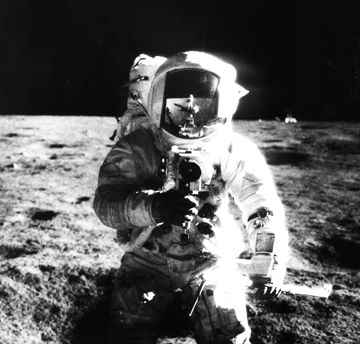
The photographer, can show of himself on the moon, as a reflection in his colleague's visor.
|
|
|
The date was 20 July 1969. It is already a quarter of a century ago. Most middleaged people still remember exactly where they were when the television pictures from the moon were first broadcast around the world. Over 500 million spectators followed this historic direct transmission.
Neil Armstrong, commander of the Eagle, was the first man to set foot on the moon. He was shortly followed by the pilot, Edwin "Buzz" Aldrin. One of the many memorable images taken at the time was that of Edwin Aldrin, a solitary man on an alien planet.
Since then this image has been printed millions of times in thousands of contexts. Among others it appeared on the covers of those international publications, TIME and National Geographic.
Take another look at the photograph. The man stands in the centre, above his head the infinite blackness of space, the moon's horizon leans suggestively, the sloping plane continues through the gilded visor, which reflects the scattered instruments, the photographer, the subject's shadow and the moon lander.
Neil Armstrong took this photograph using a Hasselblad Data Camera, the moon camera, a modified Hasselblad 500EL.
The picture was taken almost directly into the sun, yet is still perfectly exposed. It is sharply focused and the colours are brilliant, despite the harsh light. In the foreground we see footprints, while part of the moon lander chassis protrudes into the bottom right corner. This is the only shot in which both astronauts appear. It is the only photograph that Neil Armstrong can show of himself on the moon, as a reflection in his colleague's visor.
If you look at the photo closely you will see several hairline crosses. These are produced by the "Reseau plate" that was built into the camera and thereby transformed it into a hand-held measuring camera. Such cameras are usually much larger or fitted with glass plates instead of film, and are mostly used in cartography.
A Tradition in Space
Once Apollo 11 had returned to Earth, the films had been processed and the images transmitted all over the world, the camera became just as famous as the history-making astronauts. Since then, not a single manned American space mission has been launched without a Hasselblad camera on board.
However Hasselblad came into the picture long before that. When a few of the space pioneers sat down to sketch out how a practical space camera should look one of them had suddenly exclaimed: "That's starting to look like my Hasselblad". The rest took him seriously and visited a nearby photographic store in the space capital, Houston in Texas. There they bought a Hasselblad 500C with a standard Planar f/2.8, 80 mm lens. The camera was stripped down to reduce its weight and make it simple to operate. In fact so much was removed that it would be no exaggeration to say they created the world's most expensive box camera.
When the films from the first journey were developed everyone was surprised at the excellent image quality. Suddenly, photography became one of the major duties of the astronauts
|
|
|
Development Takes Off
When the Mercury project succeeded the Gemini project cameras began to be modified to meet NASA specif~cations, no longer by the astronauts in Houston themselves, but by engineers at the Hasselblad factory in Gothenburg.
NASA also set up its own service department, which could take a camera apart and service it. This had to be done after every 4,000 exposures.
However, unlike Hasselblad's engineers, the NASA engineers were unable to take a camera body off the production line and modify it to create a purpose-built space camera.
This not only involved removing the covering from the camera but also painting the camera and lens barrel black to reduce the risk of stray reflections.
Mechanical modifications also had to be made. The mirror and secondary shutter were removed and the focusing screen for the reflex viewfinder was replaced with an opaque plate. Certain shutter functions were unnecessary because the lens would remain stopped down between shots. As a result the mechanism that opened the shutter on cocking could also be removed.
At the camera factory in Gothenburg a new group was set up solely to modify and develop cameras for NASA. Once the first concrete specifications for a moon camera were laid down work began in earnest. At its peak, six people were employed full time on work for NASA.
The operating controls of the camera were redesigned so that it could easily be handled by an astronaut, despite the clumsy suits they had to wear while on the moon.
| Back | Next |
Back to Photography in Malaysia Main Index Page
[Left Brain][Right brain][Home-MIR]
[Invention][Art & Design][Newsdesk][Collectibles][Clubs]
[Portfolios][Camera Shops][Suppliers][On assignments]
[Pix of the week][Trading room][Knowledge & Resources]
[Free-trade-zone][Thoughts & opinions][Links]